Construction, eNews
Know your rights: Florida mechanic’s liens made simple

In a construction project, many elements come into play: planning, design, financing, materials, contracts, workforce and more. At the end of the day, everyone in the supply chain, from the owner to the supplier, wants to get paid. For credit professionals, the concern is the same.
Why it matters: Credit professionals who understand and enforce their lien rights are more likely to secure payment for construction projects. Florida mechanic’s lien law dictates who can file a lien, which notices must be sent, critical deadlines and how to enforce or defend a claim.
Florida lienor categories
Under Chapter 713.01 of the Florida Statutes, a lienor is a person with a lien or prospective lien on real property. These include the following:
- Contractors: those in direct contract with the owner to perform work or provide materials for improvement of real property.
- Subcontractors: those in contract with the contractor to provide labor services or materials to the real property.
- Sub-subcontractors: those in contract with a subcontractor to provide labor, services and materials.
- Laborers: individuals performing labor on the property for its improvement.
- Materialmen: those furnishing materials for improvement.
Other potential lienors include professional lienors, such as architects, landscape architects, interior designers, engineers and surveyors who provide professional services used in connection with improving real property. The requirements you must meet to protect your lien rights depend on which category you fall into.
Prerequisites to obtain lien rights
To obtain lien rights in Florida, lienors are to be licensed for the work they are performing on a project and must comply with statutory requirements.
Before construction starts, a Notice of Commencement (NOC) is served to announce the project and lists key stakeholders. The parties designated in the NOC must appear in the official records of the county in which the property is located, as all parties listed on that notice are required to be served with the Notice to Owner (NTO).
Typically, the owner is responsible for preparing the NOC by gathering job information such as property location or the type of improvement that is going to be performed. Oftentimes, the notice is prepared by the contractor before it is signed by the owner. However, it’s important to note that the information in an NOC is not always accurate. “It is a best practice to serve those designated in the NOC, but also to verify the information that’s contained in the notice,” said Sarah Naccache, associate litigation attorney at Kass Shuler Law Firm (Tampa, FL), during the NACM webinar, Nailing Down Your Rights: Florida Mechanic’s Liens Explained.
Anyone not in privity (or in direct contract) with the owner is required to serve an NTO to preserve their right to place a lien on the property for non-payment. Subcontractors, in this case, are mandated to timely serve an NTO on the owner, while a sub-subcontractor or materialman to a subcontractor is required to serve the notice on the owner and the contractor. A materialman to a sub-subcontractor must timely serve the notice on the owner, the contractor and on the subcontractor if the name and address are known.
“There are limited exceptions for laborers and subdivision work, however, if you aren’t sure if you are an exception to this rule, then you should serve an NTO to ensure your lien rights are protected,” said Naccache.
The NTO should be submitted before commencing work or within 45 days of starting work. If there is a payment bond, a Notice to Contractor (or preliminary notice) is required for those not in privity with the contractor. “When in doubt, serve both a Notice to Owner and a Notice to Contractor,” said James Shuler, senior partner at Kass Shuler Law Firm (Tampa, FL), during the webinar. “This is effective because if the bonding company goes out of business, you still have lien rights if you served an NTO on the owner.”
Statutory requirements for Notice to Owner
Under Chapter 713.06 (2)(c) of the Florida Statutes, there’s a statutory form for an NTO. The lien law stipulates that the form must include the name and address(es) of the owner, contractor, subcontractor and lienor. “It’s important to incorporate a warning at the top of the page; failure to do so can render your NTO invalid,” said Shuler. This warning generally informs a property owner about the potential for a lien to be placed on their property if the subcontractors or suppliers who sent the notice are not paid.
Moreover, an NTO should contain a description sufficient for identification of the real property. “In subdivision work, you must reference the Notice of Commencement and any deeds, portfolio(s) or ID number to the right of the property,” said Shuler. “This is helpful in identifying the property specifically, especially if the owner has multiple parcels.”
It is also important to include a description of services and materials being furnished on the project. If services or materials change or more are added, you should provide another NTO including those changes or add-ons.
The NTO must be served to the appropriate addresses by hand delivery, registered mail, certified mail or posted on the job site. NTOs are to be sent to addresses listed on the Notice of Commencement. If there is no NOC, then the addresses listed on the building permit or public records, such as the property appraiser, will suffice. Sending the NTO to the proper address(es) makes it easier to serve the notice in a timely manner.
“If you mail the notice within 40 days of the first furnishing and keep a mail log that shows the tracking number and the date the USPS received it, then it’s presumed that the owner or those addressed has received the NTO by the 45th day and you won’t have to worry about their actual receipt or turning away the delivery,” said Naccache.
Statutory requirements for claim of lien
Under Chapter 713, a claim of lien has to be recorded within 90 days of final furnishing of labor, services or materials. It does not include warranty or corrective work but does include rental equipment available for use. “You’re going to want to record a lien, even if you have a private bond claim because if the bonding company goes out of business, you can secure your lien rights,” said Naccache.
Furthermore, it is required to serve a copy of lien on the owner before recording or within 15 days of recording the claim of lien. If you fail to comply, it does not mean that your lien is not enforceable. However, if the owner finds prejudice within the form, such as an error in the legal description of the property or the dates of furnishing, it can bar the claim. “To mitigate risk, assume that you may be recording a lien on every job you do and make sure you’re staying on top of your Notices to Owner,” said Shuler.
Under Chapter 713.08 (3) of the Florida Statutes, a claim of lien requires the lienor’s name and address consistent with the contract with the NTO. The form must state the name of the person in privity with the lienor, such as the contractor or subcontractor, as well as the description and total value of the services and materials furnished. “If you have multiple Notice to Owners, make sure that you include the value of all the services and materials you furnished, including the total value of those services,” said Naccache.
Additionally, a claim of lien should contain the property’s description, the owner’s name and the date of first and final furnishing. If applicable, it can include the date and method of service of the NTO or NTC.
The lien claim should include the principal amount remaining from the contract, authorized change orders and contractually finance charges. As of 2023, Chapter 713 defines a ‘finance charge’ as a contractually specified additional amount paid by a debtor on any balance that is not paid by the due date set forth in the credit agreement. “Interest fees, late fees or attorneys’ fees are not considered finance charges so do not include them in the lien amount,” said Naccache. “Overstating can create a fraudulent lien.”
How to enforce lien rights and bars to enforcement
Untimely or improper handling of Notices to Owner or Claims of Lien will bar your enforcement to your lien. For instance, using an improper service method or listing an incorrect owner constitutes a complete loss of lien rights. Ensuring that you follow statutory requirements and ensure accuracy of information on all notices and claim will ensure your lien rights are protected
In Florida, unlicensed contracting completely bars you from pursuing not only lien rights, but also claims for breach of contract, unjust enrichment and quantum meruit (a legal term meaning allowing someone to recover reasonable compensation for services or materials provided, even when there’s no formal contract in place). “You are essentially not allowed to enforce any payment whatsoever if you were not licensed to be doing that work,” said Naccache. “Unfortunately, the owner can enforce the contract against the unlicensed contractor or subcontractor.”
You cannot enforce your lien if you fail to serve the Contractor’s Final Payment Affidavit at least five days before filing your lawsuit. There may be cases in which you can amend your complaint to include proof that the affidavit was served if you are still within the one-year statute of limitations to file the lawsuit. In those situations, you may be able to cure the failure to serve the affidavit five days beforehand. However, doing so will typically cost more in attorney’s fees than simply serving it properly before filing suit.
Failure to timely file a claim prevents you from asserting your lien rights. Under Chapter 713, the owner can file a Notice of Contest, allowing them to challenge a lien filed against their property, compelling the lienor to take action within a specified timeframe. By doing so, owners can shorten the deadline for filing a suit to 60 days from the date. If they request a Show Cause action, they can shorten the deadline further, giving the lienor as little as 20 days to respond to the filing and enforce their lien rights.
Finally, recording a fraudulent lien also renders the lien unenforceable. A fraudulent lien requires a willful exaggeration of the work performed or the amount owed. Unfortunately, this standard is largely left to the court’s discretion, so it is critical to be consistent in the amounts claimed and to maintain documentation supporting the amount you are seeking.
The bottom line: Staying informed, tracking deadlines and keeping consistent with contract information will help you protect your lien rights for construction projects in Florida.





